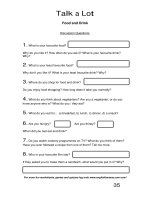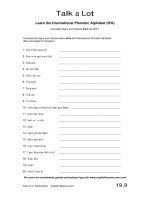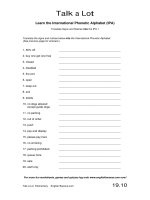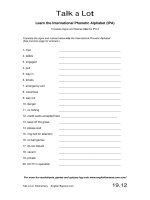talk a lot discussion words and question sheets instructions
Bạn đang xem bản rút gọn của tài liệu. Xem và tải ngay bản đầy đủ của tài liệu tại đây (28.22 KB, 3 trang )
Talk a Lot
How to Use
Discussion Words and Question Sheets – Instructions
It’s amazing how much you can do with forty cut-out vocabulary words! We have outlined
many activities for using these words with students on the discussion words question sheets.
First of all, print a discussion words page onto thin card and cut up the cards with scissors. If
possible you could laminate them to make them extra sturdy.
The main activity goes as follows: sit down with the whole class around a large table and lay
out all of the cards face down. Students take a number of cards each. The number they take
depends on the number of students in the class and for how long the teacher wants the
activity to last, e.g. for a ten minute activity ten students could each take two cards.
Go around the group one student at a time. Each student chooses one of their cards and has
to describe the word in English without saying it. The other students have to guess the word.
The students could use dictionaries to find new words that they don’t know. It’s possible for
students to make this activity deliberately harder for their peers by giving more cryptic
descriptions!
Using the Question Sheets
The teacher reads the questions out loud in a random order, or one or more of the students
could read out the questions. The teacher should use as many of the questions as is
necessary to fill the time that they have allotted to this activity. For example, if you have 25
minutes for this activity it’s unlikely that you will need to use the main activity as described
above as well as all of the questions on the handout. As with the Talk a Lot course in general,
there is more material here than will probably be needed; but as all teachers know, it’s better
to have too much material planned for a lesson than not enough!
Extension Activities
•
The students work on the main activity with the words in pairs or small groups.
•
The students have to think of ten, twenty, thirty or forty additional words on the same
topic, e.g. Music, and make their own discussion words cards, using the template on
p.5.4.
•
The teacher or the students invent new questions based on the original/new words,
using the template on p.5.5 for guidance.
•
Have a game of vocabulary bingo. Each student writes down fifteen words from the
forty words in three lines: five on the top, five on the middle and five on the bottom.
The teacher reads out words from the group at random. The students cross out the
words they have written down when they hear the teacher say them. The students
race to see who can cross off the first line, then two lines, then all of the words.
•
“Yes/No” questions: one student takes a card with a word on it, keeping it secret from
the others, who have to ask “Yes/No” questions in order to find out what the word is.
The first student can only answer “Yes” or “No”. For example, for words on the topic
of “Cars”, the other students could ask: “Is it inside a car?”, “Can I put my foot on it?”,
“Does it play music?”, etc. until they are able to guess the identity of the word. This is
a great activity to get students making questions with inversion.
For more fun worksheets, games and quizzes log onto www.englishbanana.com now!
Talk a Lot Elementary
English Banana.com
5.1
Talk a Lot
How to Use
Discussion Words and Question Sheets – Instructions
•
The students match the phonetic and English spellings of different words, translate
words into/from the IPA, or group words by the sounds they contain. (See p.18.29 for
discussion words from Book 1 and p.18.34 for discussion words from Book 2.)
•
A student mimes different words without talking, while the others have to guess them.
•
Word association activities:
a) the teacher (or a student) chooses a word and each student has to say six words
that they associate with this word, or each student in the group has to say one
word. For example, if the word is “head” the students could say “nose”, “face”,
“eye”, “ear”, “chin”, “mouth”, and so on.
b) the teacher (or a student) chooses a word and the first student says the first word
that comes into their head, followed by the next student and the next in a kind of
word association chain. See how long your group can go for without running out
of steam. You may be surprised where you end up! For example: “dog” > “bark” >
“tree” > “field” > “farm” > “cow” > “milk”, and so on.
•
Improvisation: a student is given a word (or chooses one) and has to talk about it for
a set period of time, e.g. twenty seconds. If the student pauses for longer than, say,
five seconds, the word passes to the next student, or a new word is given. For higher
level groups you could lengthen the period of time, e.g. to one minute. You could give
points to each student for the length of time that they manage to talk without a long
pause, and add them together to get a winner at the end of the game. For example, if
the student talks for fifteen seconds, you would give them fifteen points, and so on.
•
Play vocabulary battleships! Students have to work in pairs and they both have a
copy of the discussion words page from that lesson’s topic, e.g. “Sport”. They should
label the columns at the top A, B, C, and D, and the rows on the left-hand side from
top to bottom 1-10, so that the word “volleyball” is in cell B5, for example. Each
student marks ten random cells in their grid – these are their “battleships”. Without
showing their page, Student A asks for a cell on Student B’s grid, for example, “Can I
have D5, please?” If this cell (“cue”) has not been marked as a battleship, Student B
says, “Miss!” and play passes to them. Student B now requests a cell on Student A’s
grid, e.g. “I would like A6, please”, which is “swimming”. If “swimming” has been
marked as a battleship, Student A must speak in English for at least twenty seconds
about that word – without pausing! If they can do it, play passes back to them. If they
can’t do it, Student A’s battleship is “sunk” (and crossed out on both grids) and
Student B can choose another cell on the grid. The object of the game is to sink all of
your partner’s battleships by: a) guessing the correct grid reference, and b) speaking
for twenty seconds (or longer) about the vocabulary word, without pausing. This is a
great game to get students speaking in English, as well as to encourage creativity
and lateral thinking.
You could make any of these activities into a competition – individual or team – with points
given for correct answers, and prizes. The teacher could even deduct points for incorrect
answers. Prizes could be awarded for the first student to answer a question correctly, or the
student who wins the vocabulary bingo, or who can think of the most new words on the same
topic without a dictionary. For a fun group competition there could be a league, with the same
For more fun worksheets, games and quizzes log onto www.englishbanana.com now!
Talk a Lot Elementary
English Banana.com
5.2
Talk a Lot
How to Use
Discussion Words and Question Sheets – Instructions
teams competing in each lesson for points that accumulate towards a running total. It
depends on how competitive your students are!
Assessment
Assessment is performed by the teacher checking and correcting during the task, listening for
errors that can be dissected later on in a group feedback session, giving individual as well as
group feedback, and referring students back to:
a) the grammar they are learning from forming the sentence blocks, and building
sentences
b) the pronunciation work they are doing using the techniques of connected speech and
the IPA
Each student’s achievement in this activity is also recorded as part of their overall lesson
score (for both accuracy and effort) by the teacher on their course report.
For more fun worksheets, games and quizzes log onto www.englishbanana.com now!
Talk a Lot Elementary
English Banana.com
5.3









